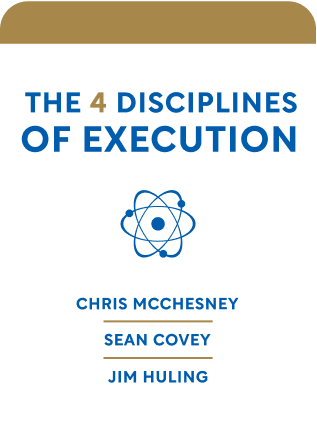

This article is an excerpt from the Shortform book guide to "The 4 Disciplines of Execution" by Chris McChesney, Sean Covey, and Jim Huling. Shortform has the world's best summaries and analyses of books you should be reading.
Like this article? Sign up for a free trial here .
Are you looking for The 4 Disciplines of Execution discussion questions? Do you want help reflecting on and apply the book’s lessons?
The 4 Disciplines of Execution discussion questions focus on the key lessons of the book. These exercises help you think about the best way to apply them to your own life and workplace.
Read on for a list of The 4 Disciplines of Execution discussion questions.
The 4 Disciplines of Execution Discussion Questions
When you want to make a change, you come up with a strategy. That’s the easy part—next you have to figure out how to implement the strategy. The 4 Disciplines of Execution harnesses and hones four disciplines that, when properly and specifically applied, allow you to carry out your strategy. When you make use of 1) focus, 2) leverage, 3) engagement, and 4) accountability, not only will you execute your strategies, you’ll create permanent behavioral change and increase engagement. Here are The 4 Disciplines of Execution discussion questions to help you.
Discussion Questions About Focus
Most leaders know that focus is important but find it difficult to do.
- What factors make it difficult for you to choose a focus? Consider internal factors such as your own nature or desire to look good, what others ask of you, and your whirlwind.
- Think of three new projects you’re excited to work on. Then, choose only one of them. How did you decide which one to pick?
Find Lead Measures
There are four steps to finding lead measures.
- Recall the team WIG you came up with in the previous exercise. Brainstorm a list of possible lead measures that will affect the WIG’s lag measures (X and Y). Remember, lead measures must be both predictable and influenceable.
- Think about how the lead measures you came up with above will influence your team WIG. You probably came up with several good ideas—narrow the list down to the most impactful two or three.
- Test your top lead measure ideas. Are they maintainable, measurable, impactful? What makes them so? Do team members move the measures, instead of the leader? How do you know?
- Write your lead measure in its final form. Start with a simple verb and keep the wording concise and concrete. Consider: are your tracking individual or team performance? Is the timeline daily or weekly? How much and how well should the measure be executed?
What Engages You?
People are most engaged when they feel like they’re playing a game they can win. The 4 Disciplines of Execution discussion questions below are all about engagement and scoring.
- Imagine the last time you did something without keeping track of the score. For example, you might have been playing catch with your daughter, reading a book, or making dinner. How motivated and engaged were you?
- Now, imagine you were doing a version of that activity that involved competition. The examples from above transform into playing a baseball game, coming up with the most insightful response in your book club, and competing in Iron Chef. How motivated and engaged are you now?
- Pick an activity you’d like to get better at. How can you use competition to increase your engagement?
The 4 Disciplines of Execution Discussion Questions on Scoreboards
There are four steps to creating a player’s scoreboard.
- Recall the WIG and lead measures you came up with in the previous two exercises. Think about what scoreboard format would be most appropriate. Remember, some of the options are trend lines, bar charts, gauges, and andon charts.
- Test your scoreboard. Is it simple, visible, complete, and quick to read? What makes it so? Where will you display it?
- Imagine you’ve asked your team to physically create the scoreboard. What materials can you give them to build and personalize it?
- Consider your team members, and which of them would make good scorekeepers. Remember that the board must be updated at least weekly to be effective. What individual or group do you trust with this responsibility?
Run a WIG Session
The WIG session has a very specific agenda. Imagine you’re leading a WIG session. Recall your WIG, lead measures, and scoreboard from the previous exercises. Use these The 4 Disciplines of Execution discussion questions to help you.
- The first step of a WIG session is to review the scoreboard. Picture your scoreboard—how will you summarize it for your team? (Consider if your lead measures are moving your lag measures, and if the team or individuals are meeting or exceeding the performance standard on the lag measures.) How will you celebrate top performance?
- The second step of a WIG session is to report on last week’s commitments. Recall one of the commitments you made in the exercise after Discipline 4 (or invent a new one). Assume you completed it. What did you learn? How do you feel about successful completion?
- The third step is to make new commitments for next week. As the leader, you can make a commitment that moves the lead measure, or a commitment to helping the team improve their execution. What is your new commitment? How did you choose it?
- What will you do if a team member tells you that they weren’t able to complete their commitment from last week?

———End of Preview———
Like what you just read? Read the rest of the world's best book summary and analysis of Chris McChesney, Sean Covey, and Jim Huling's "The 4 Disciplines of Execution" at Shortform .
Here's what you'll find in our full The 4 Disciplines of Execution summary :
- The 4 disciplines that can make any strategy a successful reality
- Why a great plan falls apart when you don't think adequately about execution
- The 6 steps you need to scale the 4DX model across an entire organization






